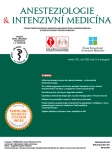Takotsubo syndrome during thoracic spinal surgery. Case report
Authors:
V. Dostálová 1; T. Hosszú 2; M. Solař 3; P. Dostál 1
Authors‘ workplace:
Klinika anesteziologie, resuscitace a intenzivní medicíny, Fakultní nemocnice Hradec Králové, Lékařská fakulta v Hradci Králové, Univerzita Karlova
1; Neurochirurgická klinika, Fakultní nemocnice Hradec Králové, Lékařská fakulta v Hradci Králové, Univerzita Karlova
2; I. interní kardioangiologická klinika, Fakultní nemocnice Hradec Králové, Lékařská fakulta v Hradci Králové, Univerzita Karlova
3
Published in:
Anest. intenziv. Med., 30, 2019, č. 3-4, s. 126-129
Category:
Overview
Takotsubo cardiomyopathy (syndrome) is acute and reversible systolic dysfunction in the apical and middle areas combined with hypercontractility of the basal segment of the left ventricle. The clinical presentation of Takotsubo is similar to that of an acute coronary syndrome and myocardial infarction with ST elevation and cardiac enzyme rise. Coronarography is negative. Takotsubo cardiomyopathy affects especially postmenopausal women and the main trigger is severe psychological stress. Recently, several case reports described the onset of Takotsubo cardiomyopathy intraoperatively in patients undergoing thoracic spine surgery. We report the case of a 71-year old female developing severe haemodynamic instability and ST segment elevation during thoracic spinal surgery for haemangioma. There was a disorder of the basal and lateral wall kinetics of the left ventricle on the postoperative echocardiogram and negative coronarography. Cardiac catheterization confirmed absence of any critical coronary disease but presence of typical apical ballooning and midventricular hypokinesis with ejection fraction of the left ventricle of 36% on ventriculography. Troponin T reached maximal levels on the first postoperative day (781 ng/l). The kinetics of the left ventricle normalized and the stabilisation of the thoracic spine was completed without any others complications after 21 days of conservative therapy.
Keywords:
Takotsubo cardiomyopathy – Takotsubo syndrome – thoracic spinal surgery – acute coronary syndrome
Sources
1. Akashi YJ, Ishihara M. Takotsubo syndrome: insights from Japan. Heart Fail Clin. 2016;12:587–595. doi: 10.1016/j.hfc.2016.06.009.
2. Raj SR. Too sympathetic? Role of sympathoexcitation in Takotsubo cardiomyopathy. Heart Rhythm. 2010;7:1833–1834. doi: 10.1016/j.hrthm.2010.09.018.
3. Maron BJ, Towbin JA, Thiene G, et al. Contemporary definitions and classification of the cardiomyopathies: an American Heart Association Scientific Statement from the Council on Clinical Cardiology, Heart Failure and Transplantation Committee; Quality of Care and Outcomes Research and Functional Genomics and Translational Biology Interdisciplinary Working Groups; and Council on Epidemiology and Prevention. Circulation. 2006;113:1807–1816.
4. Ghadri JR, Wittstein IS, Prasad A. International Expert Consensus Document on Takotsubo Syndrome (Part I): clinical characteristics, diagnostic criteria, and pathophysiology. Eur Heart J. 2018;39:2032–2046. doi: 10.1093/eurheartj/ehy076.
5. Ozpelit E, Ozpelit ME, Akdeniz B, Göldeli Ö. Ergotamine-induced takotsubo cardiomyopathy. Am J Ther. 2016;23:e597–600. doi: 10.1097/MJT.0000000000000030.
6. Nef HM, Möllmann H, Kostin S. Tako-Tsubo cardiomyopathy: intraindividual structural analysis in the acute phase and after functional recovery. Eur Heart J. 2007;28:2456–2464. doi: 10.1093/eurheartj/ehl570.
7. Hammer N, Kühne C, Meixensberger J. Takotsubo cardiomyopathy – an unexpected complication in spine surgery. Int J Surg Case Rep. 2015;6C:172–174. doi: 10.1016/j.ijscr.2014.10.002.
8. Ghadri JR, Wittstein IS, Prasad A, et al. International expert consensus document on takotsubo syndrome (part II): diagnostic workup, outcome, and management. Eur Heart J. 2018;39:2047–2062. doi: 10.1093/eurheartj/ehy077.
Labels
Anaesthesiology, Resuscitation and Inten Intensive Care MedicineArticle was published in
Anaesthesiology and Intensive Care Medicine

2019 Issue 3-4
Most read in this issue
- Kapilární návrat – klinické vyšetření přítomnosti cirkulační koherence?
- Basic neuromodulation methods in chronic pain management
- De-escalation of antibiotic therapy as a part of care strategy about critically ill patients
- Zajištění obtížných dýchacích cest u dospělých a dětí
